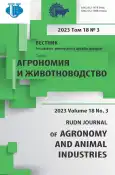Application of GIS technologies in surveying the state of forest crops in the green zone of Astana
- 作者: Kabanov A.N.1, Ospangaliev A.S.2, Kabanova S.A.1, Kochegarov I.S.1, Bekbaeva A.M.2, Danchenko M.A.3
-
隶属关系:
- A.N. Bukeikhan Kazakh Research Institute of Forestry and Agroforestry
- S. Seifullin Kazakh AgroTechnical Research University
- Tomsk State University
- 期: 卷 18, 编号 3 (2023)
- 页面: 361-372
- 栏目: Protective afforestation
- URL: https://journal-vniispk.ru/2312-797X/article/view/315748
- DOI: https://doi.org/10.22363/2312-797X-2023-18-3-361-372
- EDN: https://elibrary.ru/NWPPYB
- ID: 315748
如何引用文章
全文:
详细
When carrying out forestry, constant monitoring of plant condition and growth is very important. There is a wide range of Earth remote sensing sources for effective management of woody vegetation in vast areas. The purpose of the study was to identify areas with weekened and dying tree crops in the green observation zone of Astana, Kazakhstan, covering ‘Batys’ forestry using remote sensing data. The results of studies carried out for research on the growth and development of artificial plantations were obtained. During the experiment, a comparison of remote sensing data was performed using an unmanned aerial vehicle Supercam S350F with multispectral camera Micasense RedEdge and high-resolution measurements obtained with Sentinel‑2 and PlanetScope satellites in order to select a method for solving the tasks. Based on the materials of multispectral diagnostics, the state of forest plantations in ‘Batys’ forestry was revealed, where 35 % of tree crops were classified as healthy, 30 % — as weakened, and 35 % — as dying.
作者简介
Andrey Kabanov
A.N. Bukeikhan Kazakh Research Institute of Forestry and Agroforestry
编辑信件的主要联系方式.
Email: 7058613132@mail.ru
ORCID iD: 0000-0002-5479-3689
SPIN 代码: 9628-4453
PhD student, senior researcher
58 Kirova st., Shchuchinsk, 021704, KazakhstanAskhat Ospangaliev
S. Seifullin Kazakh AgroTechnical Research University
Email: a.ospangaliev@mail.ru
ORCID iD: 0000-0001-7478-8505
Senior lecturer
62B Zhenis st., Astana, 010000, KazakhstanSvetlana Kabanova
A.N. Bukeikhan Kazakh Research Institute of Forestry and Agroforestry
Email: kabanova.05@mail.ru
ORCID iD: 0000-0002-3117-7381
SPIN 代码: 3897-4757
Candidate of Biological Sciences, Associate Professor, Head of the Department of Reforestation and Forest Cultivation
58 Kirova st., Shchuchinsk, 021704, KazakhstanIgor Kochegarov
A.N. Bukeikhan Kazakh Research Institute of Forestry and Agroforestry
Email: garik_0188@mail.ru
ORCID iD: 0000-0003-1185-5218
SPIN 代码: 8313-4687
Junior researcher
58 Kirova st., Shchuchinsk, 021704, KazakhstanAigul Bekbaeva
S. Seifullin Kazakh AgroTechnical Research University
Email: bekbaevaaigul@gmail.com
ORCID iD: 0000-0002-3477-1888
Deputy Director, Center for technological competence in the field of digitalization of the agro-industrial complex
62B Zhenis st., Astana, 010000, KazakhstanMatvey Danchenko
Tomsk State University
Email: mtd2005@sibmail.com
ORCID iD: 0000-0002-5974-9556
SPIN 代码: 8209-8687
Candidate of Geographical Sciences, Associate Professor, Biological Institute
36 Lenin st., Tomsk, 634050, Russian Federation参考
- Gower ST. Patterns and Mechanisms of the Forest Carbon Cycle. Annual Review of Environment and Resources. 2003;28:169–204. doi: 10.1146/annurev.energy.28.050302.105515
- Suyundikov ZO. Technology of creation and maintenance of forest plantations of Astana green zone. In: Tekhnologii sozdaniya zashchitnykh nasazhdenii v prigorodnoi zone g. Astany [Technologies of creation of protective plantings in the the suburban area of Astana]. Astana; 2012. p.3–5. (In Russ.).
- Mykytanov ZK, Rakhmov GA, Baitanaev OA, Vysotsky AN. The creation of a green zone in Astana — a breakthrough project of artificial afforestation in Kazakhstan. Experimental biology. 2011;(4):15–20. (In Russ.).
- Alekseev VA. Diagnostics of the vital state of trees and stands. Russian Journal of Forest Science. 1989;(4):51–57. (In Russ.).
- Ogievskiy VV, Hirov AA. Obsledovanie i issledovanie lesnykh kul’tur [Survey and research of forest crops]. Moscow: Lesnaya promyshlennost’ publ.; 1964. (In Russ.).
- Mancino G, Ferrara A, Padula A, Nole A. Cross-Comparison between Landsat 8 (OLI) and Landsat 7 (ETM+) Derived Vegetation Indices in a Mediterranean Environment. Remote Sensing. 2020;12(2):291. doi: 10.3390/rs12020291
- Broge NH, Leblanc E. Comparing prediction power and stability of broadbandand hyperspectral vegetation indices for estimation of green leaf area index and canopy chlorophyll density. Remote Sensing of Environment. 2001;76(2):156–172. doi: 10.1016/S0034-4257(00)00197-8
- Ahammad T. Effect of chlorophyll content & solar irradiance on spectral reflectance of vegetation canopies acquired by spectro-radiometer. International Journal of Environment and Geoinformatics. 2021;9(1):170–178. doi: 10.30897/ijegeo.958100
- Gitelson AA, Gritz Y, Merzlyak MN. Relationships between leaf chlorophyll content and spectral reflectance and algorithms for non-destructive chlorophyll assessment in higher plant leaves. Journal of Plant Physiology. 2021;160(3):271–282. doi: 10.1078/0176-1617-00887
- Ovchinnikov AV. Technique for experimental study of spectral brightness coefficients materials and natural backgrounds. Journal of Radio Electronics. 2021;(6):14. doi: 10.30898/1684-1719.2021.6.5. (In Russ.).
- Breiman L. Random Forests. Machine Learning. 2001;45:5–32. doi: 10.1023/A:1010933404324
- Hastie T, Tibshirani R, Friedman JC. Random Forests. In: The Elements of Statistical Learning: Data Mining, Inference, and Prediction. 2nd ed. Springer-Verlag; 2009. p.764.
- Meng J, Li S, Wang W, Liu Q, Xie S, Ma W. Mapping forest health using spectral and textural information extracted from SPOT-5 satellite images. Remote Sensing. 2016;8(9):719. doi: 10.3390/rs8090719
- Immitzer M, Atzberger C, Koukal T. Tree species classification with random forest using very high spatial resolution 8-band WorldView-2 satellite data. Remote sensing. 2012;4(9):2661–2693. doi: 10.3390/rs4092661
- Plakman V, Janssen T, Brouwer N, Veraverbeke S. Mapping species at an individual-tree scale in a temperate forest, using Sentinel-2 images, airborne laser scanning data, and random forest classification. Remote Sensing, 2020;12(22):3710. doi: 10.3390/rs12223710
补充文件










